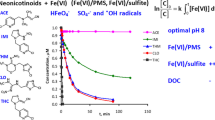Abstract
Monitoring the enforcement of an EU-wide ban of nitrofuran antibiotics in the food production chain is a challenging task, given the nature of nitrofuran compounds. The original and modified Fenton reactions are advanced oxidation processes that can eliminate the toxicity of nitrofurans. 2-(5-Nitrofuryl)acrylic acid (I) was degraded as a model compound by the original Fenton reaction with ferrous sulphate, by Mohr’s salt at pH 3 and 7, and finally by advanced Fenton process (AFP) (Fe0/H2O2/H2SO4). In addition, the growth inhibition of Escherichia coli, a G− bacterium, was tested both before and after AFP treatment. The results showed that a small degradation efficiency of this treatment process led to the toxicity changes and that the toxicity of I after AFP treatment process decreased. It seems that the treatment of polluted water using the Fenton reaction and its modifications would be a suitable method for degradation of nitrofuran derivatives in polluted water.
Similar content being viewed by others
References
Bartel, L. C., Montalto de Mecca, M., & Castro, J. A. (2009). Nitroreductive metabolic activation of some carcinogenic nitro heterocyclic food contaminants in rat mammary tissue cellular fractions. Food and Chemical Toxicology, 47, 140–144. DOI: 10.1016/j.fct.2008.09.069.
Chen, J., Xiu, Z., Lowry, G. V., & Alvarez, P. J. J. (2011). Effect of natural organic matter on toxicity and reactivity of nano-scale zero-valent iron. Water Research, 45, 1995–2001. DOI: 10.1016/j.watres.2010.11.036.
Cooper, K. M., Mulder, P. P. J., van Rhijn, J. A., Kovacsics, L., McCracken, R. J., Young, P. B., & Kennedy, D. G. (2005). Depletion of four nitrofuran antibiotics and their tissuebound metabolites in porcine tissues and determination using LC-MS/MS and HPLC-UV. Food Additives & Contaminants, 22, 406–414. DOI: 10.1080/02652030512331385218.
Derco, J., Žgajnar Gotvajn, A., Zagorc-Končan, J., Almásiová, B., & Kassai, A. (2010). Pretreatment of landfill leachate by chemical oxidation processes. Chemical Papers, 64, 237–245. DOI: 10.2478/s11696-009-0116-5.
Gomathi Devi, L., Girish Kumar, S., Anantha Raju, K. S., & Eraiah Rajashenkhar, K. (2010). Photo-Fenton and photo-Fenton-like processes for the degradation of methyl orange in aqueous medium: Influence of oxidation states of iron. Chemical Papers, 64, 378–385. DOI: 10.2478/s11696-010-0011-0.
Himebaugh, R. R., & Smith, M. J. (1979). Semi-micro tube method for chemical oxygen demand. Analytical Chemistry, 51, 1085–1087. DOI: 10.1021/ac50043a072.
Jantová, S., Greif, G., Špirková, K., Stankovský, Š., & Oravcová, M. (2000). Antibacterial effects of trisubstituted quinazoline derivatives. Folia Microbiologica, 45, 133–137.
Klíma, J., Prousek, J., Ludvík, J., & Volke, J. (1984). Electrochemical investigation of radical-anion reactions of 5-nitro-2-furfuryl derivatives. Collection of Czechoslovak Chemical Communications, 49, 1627–1634. DOI: 10.1135/cccc19841627.
Kirkland, D., Reeve, L., Gatehouse, D., & Vanparys, P. (2011). A core in vitro genotoxicity battery comprising the Ames test plus the in vitro micronucleus test is sufficient to detect rodent carcinogens and in vivo genotoxins. Mutation Research, 721, 27–73. DOI: 10.1016/j.mrgentox.2010.12.015.
Leston, S., Nunes, M., Viegas, I., Lemos, M. F. L., Freitas, A., Barbosa, J., Ramos, F., & Pardal, M. A. (2011). The effects of the nitrofuran furaltadone on Ulva lactuca. Chemosphere, 82, 1010–1016. DOI: 10.1016/j.chemosphere.2010.10.067.
Mackuľak, T., Prousek, J., & Švorc, Ľ. (2011). Degradation of atrazine by Fenton and modified Fenton reactions. Monatshefte für Chemie, 142, 561–567. DOI: 10.1007/s00706-011-0504-8.
McCracken, R. J., & Kennedy, D. G. (1997). Determination of the furazolidone metabolite, 3-amino-2-oxazolidinone, in porcine tissues using liquid chromatography-thermospray mass spectrometry and the occurrence of residues in pigs produced in Northern Ireland. Journal of Chromatography B, 691, 87–94. DOI: 10.1016/S0378-4347(96)00448-3.
Prousek, J. (2007). Fenton chemistry in biology and medicine. Pure and Applied Chemistry, 79, 2325–2338. DOI: 10.1351/pac200779122325.
Prousek, J. (1980). Electron transfer processes. Reactions of 5-nitrofuryl derivatives going by anionradical mechanism. Collection of Czechoslovak Chemical Communications, 45, 3347–3353.
Prousek, J., Palacková, E., Priesolová, S., Marková, L., & Alevová, A. (2007). Fenton- and Fenton-like AOPs for wastewater treatment: From laboratory-to-plant-scale application. Separation Science and Technology, 42, 1505–1520. DOI: 10.1080/01496390701290151.
Prousek, J., & Priesolová, S. (2002). Practical utilization of zero-valent iron in Fenton reaction for treatment of coloured waste waters. Chemické Listy, 96, 893–896. (in Czech)
Radovnikovic, A., Moloney, M., Byrne, P., & Danaher, M. (2011). Detection of banned nitrofuran metabolites in animal plasma samples using UHPLC-MS/MS. Journal of Chro matography B, 879, 159–166. DOI: 10.1016/j.jchromb.2010.11.036.
Stiborová, M. (2002). Nitroaromatic compounds: Environmental pollutants with carcinogenic potential for humans. Chemické Listy, 96, 784–791. (in Czech)
Vieites, M., Otero, L., Santos, D., Olea-Azar, C., Norambuena, E., Aguirre, G., Cerecetto, H., González, M., Kemmerling, U., Morello, A., Maya, J. D., & Gambino, D. (2009). Platinum-based complexes of bioactive 3-(5-nitrofuryl)acroleine thiosemicarbazones showing anti-Trypanosoma cruzi activity. Journal of Inorganic Biochemistry, 103, 411–418. DOI: 10.1016/j.jinorgbio.2008.12.004.
Wang, Y., Gray, J. P., Mishin, V., Heck, D. E., Laskin, D. L., & Laskin, J. D. (2008). Role of cytochrome P450 reductase in nitrofurantoin-induced redox cycling and cytotoxicity. Free Radical Biology & Medicine, 44, 1169–1179. DOI: 10.1016/j.freeradbiomed.2007.12.013.
Author information
Authors and Affiliations
Corresponding author
Rights and permissions
About this article
Cite this article
Mackuľak, T., Olejníková, P., Prousek, J. et al. Toxicity reduction of 2-(5-nitrofuryl)acrylic acid following Fenton reaction treatment. Chem. Pap. 65, 835–839 (2011). https://doi.org/10.2478/s11696-011-0075-5
Received:
Revised:
Accepted:
Published:
Issue Date:
DOI: https://doi.org/10.2478/s11696-011-0075-5




